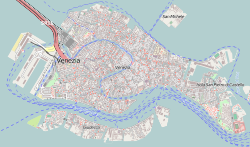You can help expand this article with text translated from the corresponding article in Italian. (August 2012)Click [show] for important translation instructions.
|
| Santa Maria Formosa | |
|---|---|
 Santa Maria Formosa: north facade | |
| Religion | |
| Affiliation | Roman Catholic |
| Province | Venice |
| Location | |
| Location | Venice, Italy |
| Coordinates | 45°26′13″N12°20′28″E / 45.4369°N 12.3411°E |
| Architecture | |
| Completed | 1492 |
Santa Maria Formosa, formally The Church of the Purification of Mary, is a church in Venice, northern Italy. It was erected in 1492 under the design by Renaissance architect Mauro Codussi. It lies on the site of a previous church dating from the 7th century, which, according to tradition, was one of the eight founded by San Magno, bishop of Oderzo. The name "formosa" relates to an alleged appearance of the Holy Virgin disguised as a voluptuous woman1.






